Yusong Zhang
RLMR: Reinforcement Learning with Mixed Rewards for Creative Writing
Aug 28, 2025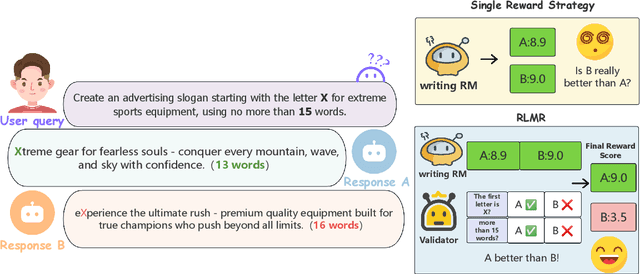
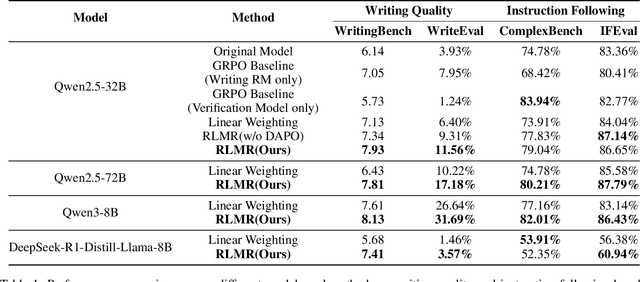
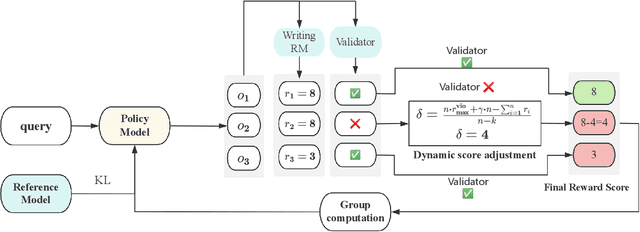
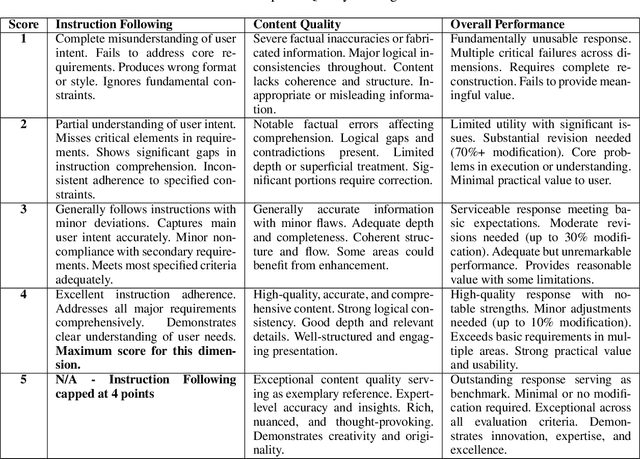
Abstract:Large language models are extensively utilized in creative writing applications. Creative writing requires a balance between subjective writing quality (e.g., literariness and emotional expression) and objective constraint following (e.g., format requirements and word limits). Existing methods find it difficult to balance these two aspects: single reward strategies fail to improve both abilities simultaneously, while fixed-weight mixed-reward methods lack the ability to adapt to different writing scenarios. To address this problem, we propose Reinforcement Learning with Mixed Rewards (RLMR), utilizing a dynamically mixed reward system from a writing reward model evaluating subjective writing quality and a constraint verification model assessing objective constraint following. The constraint following reward weight is adjusted dynamically according to the writing quality within sampled groups, ensuring that samples violating constraints get negative advantage in GRPO and thus penalized during training, which is the key innovation of this proposed method. We conduct automated and manual evaluations across diverse model families from 8B to 72B parameters. Additionally, we construct a real-world writing benchmark named WriteEval for comprehensive evaluation. Results illustrate that our method achieves consistent improvements in both instruction following (IFEval from 83.36% to 86.65%) and writing quality (72.75% win rate in manual expert pairwise evaluations on WriteEval). To the best of our knowledge, RLMR is the first work to combine subjective preferences with objective verification in online RL training, providing an effective solution for multi-dimensional creative writing optimization.
Hunyuan-TurboS: Advancing Large Language Models through Mamba-Transformer Synergy and Adaptive Chain-of-Thought
May 21, 2025Abstract:As Large Language Models (LLMs) rapidly advance, we introduce Hunyuan-TurboS, a novel large hybrid Transformer-Mamba Mixture of Experts (MoE) model. It synergistically combines Mamba's long-sequence processing efficiency with Transformer's superior contextual understanding. Hunyuan-TurboS features an adaptive long-short chain-of-thought (CoT) mechanism, dynamically switching between rapid responses for simple queries and deep "thinking" modes for complex problems, optimizing computational resources. Architecturally, this 56B activated (560B total) parameter model employs 128 layers (Mamba2, Attention, FFN) with an innovative AMF/MF block pattern. Faster Mamba2 ensures linear complexity, Grouped-Query Attention minimizes KV cache, and FFNs use an MoE structure. Pre-trained on 16T high-quality tokens, it supports a 256K context length and is the first industry-deployed large-scale Mamba model. Our comprehensive post-training strategy enhances capabilities via Supervised Fine-Tuning (3M instructions), a novel Adaptive Long-short CoT Fusion method, Multi-round Deliberation Learning for iterative improvement, and a two-stage Large-scale Reinforcement Learning process targeting STEM and general instruction-following. Evaluations show strong performance: overall top 7 rank on LMSYS Chatbot Arena with a score of 1356, outperforming leading models like Gemini-2.0-Flash-001 (1352) and o4-mini-2025-04-16 (1345). TurboS also achieves an average of 77.9% across 23 automated benchmarks. Hunyuan-TurboS balances high performance and efficiency, offering substantial capabilities at lower inference costs than many reasoning models, establishing a new paradigm for efficient large-scale pre-trained models.
Human-LLM Collaborative Construction of a Cantonese Emotion Lexicon
Oct 15, 2024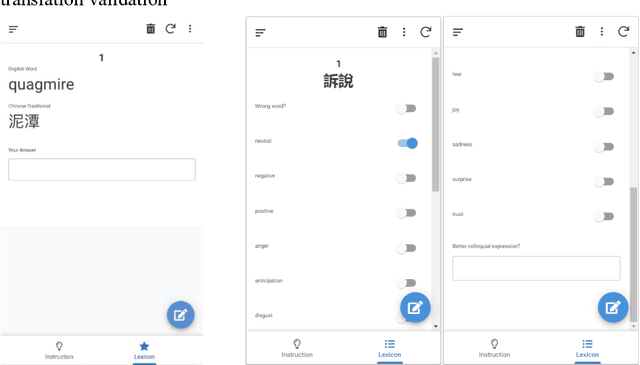
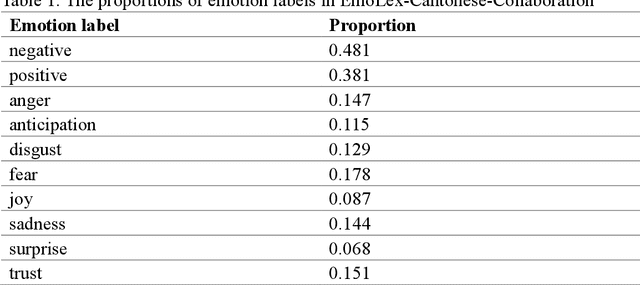
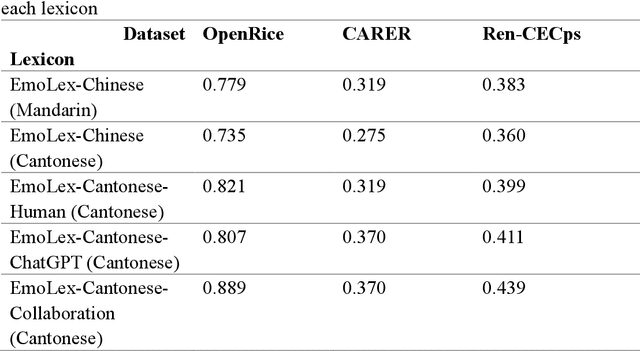
Abstract:Large Language Models (LLMs) have demonstrated remarkable capabilities in language understanding and generation. Advanced utilization of the knowledge embedded in LLMs for automated annotation has consistently been explored. This study proposed to develop an emotion lexicon for Cantonese, a low-resource language, through collaborative efforts between LLM and human annotators. By integrating emotion labels provided by LLM and human annotators, the study leveraged existing linguistic resources including lexicons in other languages and local forums to construct a Cantonese emotion lexicon enriched with colloquial expressions. The consistency of the proposed emotion lexicon in emotion extraction was assessed through modification and utilization of three distinct emotion text datasets. This study not only validates the efficacy of the constructed lexicon but also emphasizes that collaborative annotation between human and artificial intelligence can significantly enhance the quality of emotion labels, highlighting the potential of such partnerships in facilitating natural language processing tasks for low-resource languages.
KPG: Key Propagation Graph Generator for Rumor Detection based on Reinforcement Learning
May 21, 2024Abstract:The proliferation of rumors on social media platforms during significant events, such as the US elections and the COVID-19 pandemic, has a profound impact on social stability and public health. Existing approaches for rumor detection primarily rely on propagation graphs to enhance model effectiveness. However, the presence of noisy and irrelevant structures during the propagation process limits the efficacy of these approaches. To tackle this issue, techniques such as weight adjustment and data augmentation have been proposed. However, these techniques heavily depend on rich original propagation structures, thus hindering performance when dealing with rumors that lack sufficient propagation information in the early propagation stages. In this paper, we propose Key Propagation Graph Generator (KPG), a novel reinforcement learning-based rumor detection framework that generates contextually coherent and informative propagation patterns for events with insufficient topology information, while also identifies indicative substructures for events with redundant and noisy propagation structures. KPG consists of two key components: the Candidate Response Generator (CRG) and the Ending Node Selector (ENS). CRG learns the latent distribution from refined propagation patterns, filtering out noise and generating new candidates for ENS. Simultaneously, ENS identifies the most influential substructures within propagation graphs and generates training data for CRG. Moreover, we introduce an end-to-end framework that utilizes rewards to guide the entire training process via a pre-trained graph neural network. Extensive experiments conducted on four datasets demonstrate the superiority of our KPG compared to the state-of-the-art approaches.
 Add to Chrome
Add to Chrome Add to Firefox
Add to Firefox Add to Edge
Add to Edge